Male Infertility Problem
In many cases, infertility problems may lie in the male and so it is important, in order to save time, effort & money, this should be found out early on.
Get Free Consultation
Explanation
Male infertility is on the rise and now accounts for nearly 40% of causes. It is seen that poor semen parameters may be due to some illness or fever or due to local infections, stress, pollution and bad diet. It could also be that there is failure of testis to produce sperm due to trauma or infections in the testis.
Local dilatation of veins of testis (varicocele) may cause a rise in temperature leading to a decreased sperm production. Sometimes due to stress or other reasons the stimulus from the brain hormones is absent to produce sperm. In men with absent sperms the outlet duct from testis may be blocked and hence sperms are absent in ejaculate.
Diagnosis can involve a medical history from the man to find out whether there are any obvious health problems that could affect fertility.
- A physical examination is done, along with a semen analysis to check the number, movement and shape of the sperm in the ejaculate. See advanced semenanalysis
- Blood tests may also be done to check the hormone levels that control sperm production.
- Genetic investigations to test for chromosomal anaomalies or Y chromosome microdeletion may be done.
Indications for Surgical Sperm Retrieval (SSR) are:
- Outlet duct obstruction: Vas deferens is the outlet duct which carries the sperms out of testis. It could be obstructed by birth, trauma , infection or surgery (Vasectomy)
- Non obstructive Azoospermia ( absent sperms) because of failed production in the testis – Causes could be poor hormonal stimulus from brain, genetic factors, trauma of infections of testis.
Once a diagnosis of azoospermia (zero sperm count) has been made, we work closely with a urologist with specialized training in male infertility who will retrieve the sperm. The urologist will first perform an exam and further testing which may involve blood work and/or a testicular biopsy. The result of these studies determine which procedure is more appropriate and more likely to yield sperm.
Did You Know?
There are nearly 40% cases of male infertility in the world.
SSR Techniques
Percutaneous Epididymal Sperm Aspiration (PESA)
A small needle is placed into the epidydimis, which is a reservoir of sperm that sits atop each testicle, using local / general anesthesia and sperms are aspirated.
Testicular Sperm Aspiration (TESA) /Testicular Sperm Extraction (TESE):
If PESA is unsuccessful, TESA or TESE may be offered. In this procedure, the sperm is obtained directly from the testicle either by a needle or a tissue biopsy.
MicroTESE
MicroTESE is done under the microscope where our urologist dissects out only microscopic tissue (tubule) from areas with dilated seminiferous tubule, identified as having active spermatogenesis. Sperm may be found in 50-60% of well-selected cases. Microscopic tissue removal ensures no harm is done to testis.
Treatment Protocol
Life Style Changes
We ensure that the male partner loses weight, takes a good diet rich in antioxidants, exercises regularly and reduces stress. At the same time he quits smoking alcohol and any other addictions.
Hormone Replacement
If hormones are deficient and are required to boost sperm production we start the replacement therapy (hCG & FSH). This therapy takes at least 3 months to show results.
Surgical Interventions
In case of dilated veins in testis surgical clipping (Variocelectomy) is done. This brings down the raised local temperature of testis enhancing sperm production. In case outlet duct (vas deferens) is blocked and the condition is good enough to try and repair.
Why Surveen Ghumman Sindhu?
Our Success Story
My pregnancy has been possible only because of Dr. Surveen Ghumman Sindhu, whose way of treating her patient is exceptional. She is so calm and kind with her patient’s right from the beginning till end.
My pregnancy has been possible only because of Dr. Surveen Ghumman Sindhu, whose way of treating her patient is exceptional. She is so calm and kind with her patient’s right from the beginning till end.
She is full of confidence and perseverance, so courageous to guide us from pessimism to optimism.
She guided us so well throughout the treatment and made it hassle free, which makes us believe in her even more.
A & N
For my infertility problem, I was very skeptical to go to a doctor who sees every patient as just another client. However, after meeting Dr. Surveen Ghumman Sindhu, a person with pleasant disposition, passionate about her work and compassionate towards her patients, all my fears vanished.
For my infertility problem, I was very skeptical to go to a doctor who sees every patient as just another client. However, after meeting Dr. Surveen Ghumman Sindhu, a person with pleasant disposition, passionate about her work and compassionate towards her patients, all my fears vanished.
I knew I was in safe hands, which helped me remain positive throughout my treatment. As a result, even at the age of 37 I was able to conceive very soon through IVF technology.
Not only Dr. Surveen, but her entire team at MAX Multi speciality Centre, Panchsheel were warm, caring and made me feel comfortable during the entire treatment.
We traveled the world for a chance to conceive. For 5 years we visited multiple gynecologists.. We did surgery after surgery. Internet searches speak of India as having high rates of success in terms of in vitro fertilization.
We traveled the world for a chance to conceive. For 5 years we visited multiple gynecologists.
We did surgery after surgery. Internet searches speak of India as having high rates of success in terms of in vitro fertilization.
So we met Dr Surveen at Max care hospital Pancheel park in Delhi. She planned the IVF quicky. The entire team was behind me with encouragement. .Dr. Surveen, It took us 6 years and more than 10,000 Kilometers further for God to put you on our path. Our son is now 9 weeks handsome and healthy.
The whole world should be aware of the tremendous work you and your team have accomplished to make this process successful.
Fatouma and Sheikh Senegal/ West Africa
Some Priceless Happiness
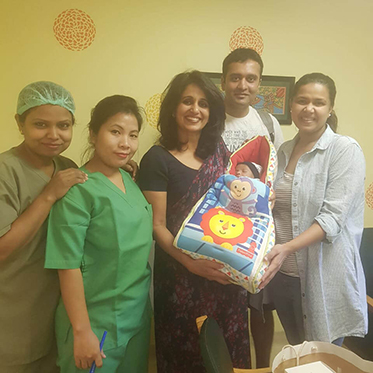
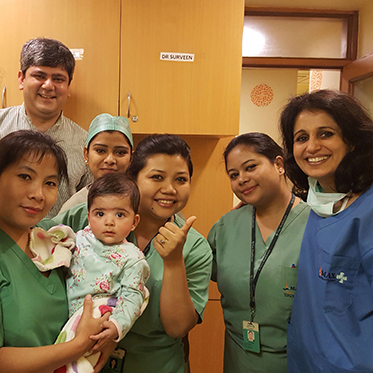

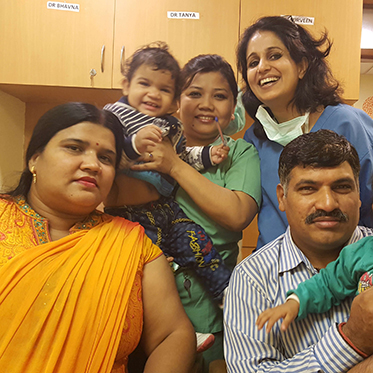




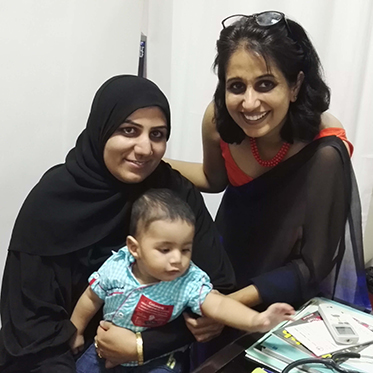


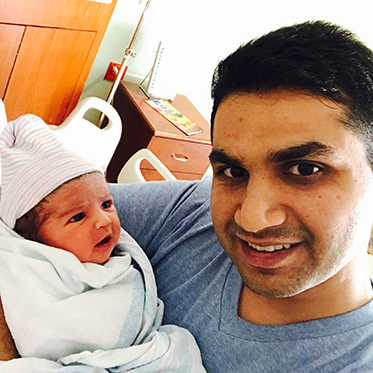

Knowledge Center
Frequently Asked Questions
1. Sperm production problems: About two-thirds of infertile men have sperm production problems.
2. Blockage of sperm transport: This is the second most common cause of male infertility and affects about one in every five infertile men
3. Sperm antibodies: In some men, substances in the semen and/or blood called sperm antibodies can develop which can reduce sperm movement and block egg binding
4. Sexual problems: Difficulties with sexual intercourse, such as erection or ejaculation problems, can also stop couples from becoming pregnant.
5. Hormonal problems: Hormonal causes are uncommon, and affect less than one in 100 infertile men
6. In many men with a sperm production problem, the cause cannot be identified.
Male infertility may be treated with medical, surgical, or assisted reproductive therapies depending on the underlying cause. A reproductive endocrinologist may offer IUI or IVF to help overcome male factor infertility. In cases where there is azoospermia i.e no sperms in the ejaculate, retrieval of sperms can be done surgically by aspiration or surgical extraction using PESA- Percutaneous epididymal sperm aspiration, TESA – Testicular sperm aspiration & TESE – Testicular sperm extraction, testicular biopsy.
Percutaneous epididymal sperm aspiration (PESA) and testicular sperm aspiration (TESA) are procedures for overcoming extreme male infertility. Men having very low or zero sperm counts, and sperm that are largely dead or completely immotile, can have children by these methods. The sperm collected can be used for intracytoplasmic sperm injection (ICSI). Yes, Dr. Surveen’s team performs such treatments for couples that require it as she has access to state of the art facilities at Delhi’s renowned hospitals.
PESA surgery can be performed under local anaesthesia or a short-acting general anaesthetic (depending upon the choice of the patient). The epididymis is aspirated to find motile sperm cells. Sperm removed are either utilized for ICSI or they are frozen for later use. Generally, this operation is reserved for instances where the obstruction has occurred. The procedure is often combined with testis biopsy for TESA.
This procedure can be used for instances where sperm production is a problem (non-obstructive azoospermia) or where there is an obstruction to sperm flow. TESA for non-obstructive azoospermia (low sperm production or maturation arrest) takes around an hour. Here both testicles are usually operated on, and multiple biopsies are taken. It is normally done under general anaesthesia. However, very often sperms can be successfully aspirated by fine-needle aspiration under local anaesthesia or without any cut or stitches.
The minute quantities of sperm obtained at retrieval are not enough to be useful for Intra-Uterine Insemination (IUI) or any procedure other than ICSI. PESA and TESE procedures are the most popular because the goal is the retrieval of sufficient sperm for freezing and use in future IVF cycles using ICSI.

